

|
 |
Delta Force (The) (Blu-ray)
[Blu-ray]
Blu-ray B - United Kingdom - Arrow Films Review written by and copyright: Paul Lewis (27th April 2014). |
|
The Film
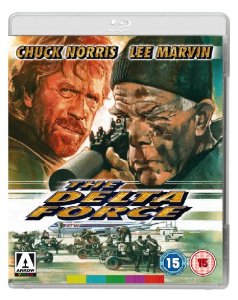 The Delta Force (Menahem Golan, 1986)  Inspired largely by the 1985 hijacking of TWA flight 847 by members of Hezbollah and the Islamic Jihad Organisation, The Delta Force (Menahem Golan, 1986) is a key example of the ethos of Cannon Films’ productions and, more generally, the excesses of 1980s action pictures. Some sequences in the film are uncomfortably close to the real story of the hijacking of the TWA flight, including the separation of passengers with Jewish names from the rest of the people on the aeroplane (who were then taken off the plane and held hostage in Beirut), and the execution of a US Navy diver who was also on the flight. (The hijacking of the TWA plane inspired a later, less sensationalistic, television film, Paul Wendkos’ The Hijacking of Flight 847: The Uli Derickson Story, 1988.) Featuring a slightly jarring fusion of outlandish action and a semi-documentary approach, with its large list of guest stars (Martin Balsam, George Kennedy, Robert Vaughn, Susan Strasberg, Bo Svenson, Shelley Winters, Joey Bishop; most of whom play passengers on the hijacked plane) The Delta Force also looks back to disaster movies of the 1970s such as Airport 1975 (Jack Smight, 1974) (see McAlister, 2005: 227). Inspired largely by the 1985 hijacking of TWA flight 847 by members of Hezbollah and the Islamic Jihad Organisation, The Delta Force (Menahem Golan, 1986) is a key example of the ethos of Cannon Films’ productions and, more generally, the excesses of 1980s action pictures. Some sequences in the film are uncomfortably close to the real story of the hijacking of the TWA flight, including the separation of passengers with Jewish names from the rest of the people on the aeroplane (who were then taken off the plane and held hostage in Beirut), and the execution of a US Navy diver who was also on the flight. (The hijacking of the TWA plane inspired a later, less sensationalistic, television film, Paul Wendkos’ The Hijacking of Flight 847: The Uli Derickson Story, 1988.) Featuring a slightly jarring fusion of outlandish action and a semi-documentary approach, with its large list of guest stars (Martin Balsam, George Kennedy, Robert Vaughn, Susan Strasberg, Bo Svenson, Shelley Winters, Joey Bishop; most of whom play passengers on the hijacked plane) The Delta Force also looks back to disaster movies of the 1970s such as Airport 1975 (Jack Smight, 1974) (see McAlister, 2005: 227).
The film opens with a sequence set in 1980, in an obvious nod to the disastrous Operation Eagle Claw (in which an attempt by American forces to rescue hostages held in Tehran resulted in the deaths of eight servicemen). Following an accident with one of the Delta Force’s helicopters, Colonel Nick Alexander (Lee Marvin) and his team abort their attempt to rescue American hostages; against the wishes of Alexander, Major Scott McCoy (Chuck Norris) performs a heroic rescue of one of his colleagues from the burning helicopter, just before it explodes. After the evacuation, with eight of his team-mates dead McCoy reflects on the incompetence of the commanders: ‘Why the hell wouldn’t they listen, Nick?’, he asks Alexander, ‘We told them it was too dangerous to launch this operation at night [….] I spent five years in Vietnam watching them do the planning and us doing the dying’. McCoy vows to resign when the team return home. Five years later, McCoy has retired to a horse ranch in Fayetteville. Meanwhile, in Athens a passenger plane prepares to take off. The plane is also boarded by two members of the New World Revolution, Abdul Raifi (Robert Forster) and Mustafa (David Menachem), both of whom are disguised as tourists. (A third member of the group is arrested when, after he is bumped to the next flight, he causes a disturbance at the airport.) Using handguns and hand grenades stowed on board the plane prior to its take off, Abdul and Mustafa hijack the flight and demand the plane be flown to Beirut. When faced with this news, in the Pentagon General Woodridge (Robert Vaughn) demands that Colonel Alexander and his team be given the task of taking on the hijackers. Seeing the news of the hijacking on television, McCoy also volunteers to be rejoin his colleagues. 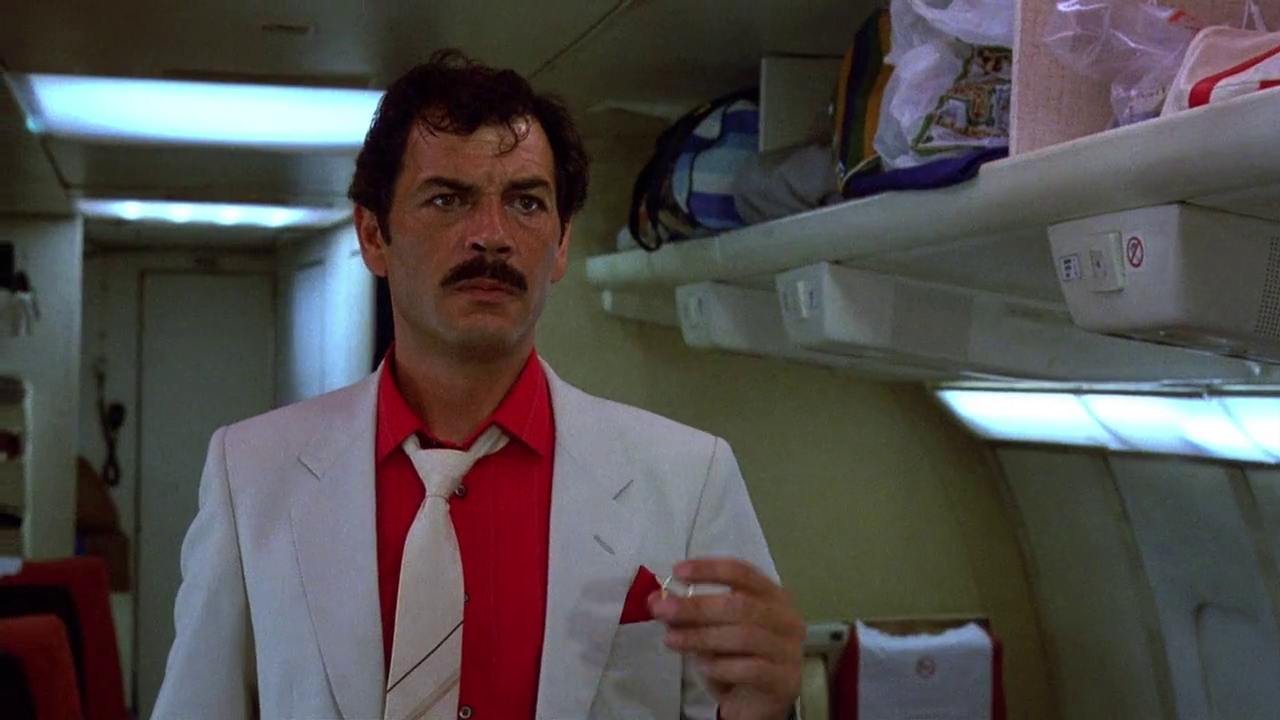 On board the plane, the hijackers isolate three US Marines who are returning from leave, and force the plane’s reluctant German purser, Ingrid (Hanna Schygulla), to separate the passengers with Jewish names from the rest of the hostages. Uncomfortable with this, owing to her nation’s Nazi past, Ingrid resists, telling the hijackers, ‘You claim to belong to a revolutionary organisation [….] But then, you [surely] don’t want to be associated with Nazis who killed six million Jews’. ‘Not enough, lady’, Mustafa responds, ‘Not enough. The Jews stole Palestine. They took our lands’. (Uli Derickson, the purser on TWA flight 847, was faced with a similar dilemma; and after the hijacking she was dogged by rumours that, on one hand, she had named Jewish passengers to the Hezbollah hijackers, and on the other hand that she had hidden the passports of Jewish passengers to protect them from the hijackers.) On board the plane, the hijackers isolate three US Marines who are returning from leave, and force the plane’s reluctant German purser, Ingrid (Hanna Schygulla), to separate the passengers with Jewish names from the rest of the hostages. Uncomfortable with this, owing to her nation’s Nazi past, Ingrid resists, telling the hijackers, ‘You claim to belong to a revolutionary organisation [….] But then, you [surely] don’t want to be associated with Nazis who killed six million Jews’. ‘Not enough, lady’, Mustafa responds, ‘Not enough. The Jews stole Palestine. They took our lands’. (Uli Derickson, the purser on TWA flight 847, was faced with a similar dilemma; and after the hijacking she was dogged by rumours that, on one hand, she had named Jewish passengers to the Hezbollah hijackers, and on the other hand that she had hidden the passports of Jewish passengers to protect them from the hijackers.)
In Beirut, whilst the plane is being refueled more hijackers sneak on board. Meanwhile, Alexander and his team, who believe there only to be two hijackers on the plane, prepare to free the hostages. When Alexander realises that the plane now holds more hijackers than he initially believed to be on board, the assault is halted. The hijackers eventually release the women and children but move the rest of the hostages to a compound in the centre of Beirut. The Delta Force team strike at the compound in Beirut, freeing the hostages there; but Alexander’s team discover that the US Marines and Jewish hostages are being moved to Syria, where the hijackers have been offered shelter by Ayatollah Khomeini. The Delta Force team follow, with the aim of freeing the remaining hostages and exacting revenge on the hijackers. For many of its early sequences, the film takes a semi-documentary approach to the material. Onscreen titles, presented over establishing shots, identify the place, date and location, in the manner of Costa-Gavras’ semi-documentary political thrillers of the 1960s and 1970s (such as Z, 1969; and État de siege/State of Siege, 1972): ‘Iran, Desert One, 2000 miles Southeast of Tehran, April 25th 1980 – 4:00am’, a title in the opening sequence tells us. The lowkey scenes on the aircraft, with strong performances from some of the secondary cast members (and a simmering performance from Robert Forster as the film’s chief ‘villain’), are offset by extravagant action scenes and, towards the end of the film, the ludicrous sight of Chuck Norris riding a motorcycle that is equipped with front-mounted machine guns and grenade launchers, and rear-mounted mortars. The contrast between the semi-documentary approach of the film’s early sequences and the increasingly absurd escalation of violence as it builds towards it climax undermines much of the dramatic potential of the narrative, and Norris’ bizarre motorcycle threatens to turn the film into a camp delight. 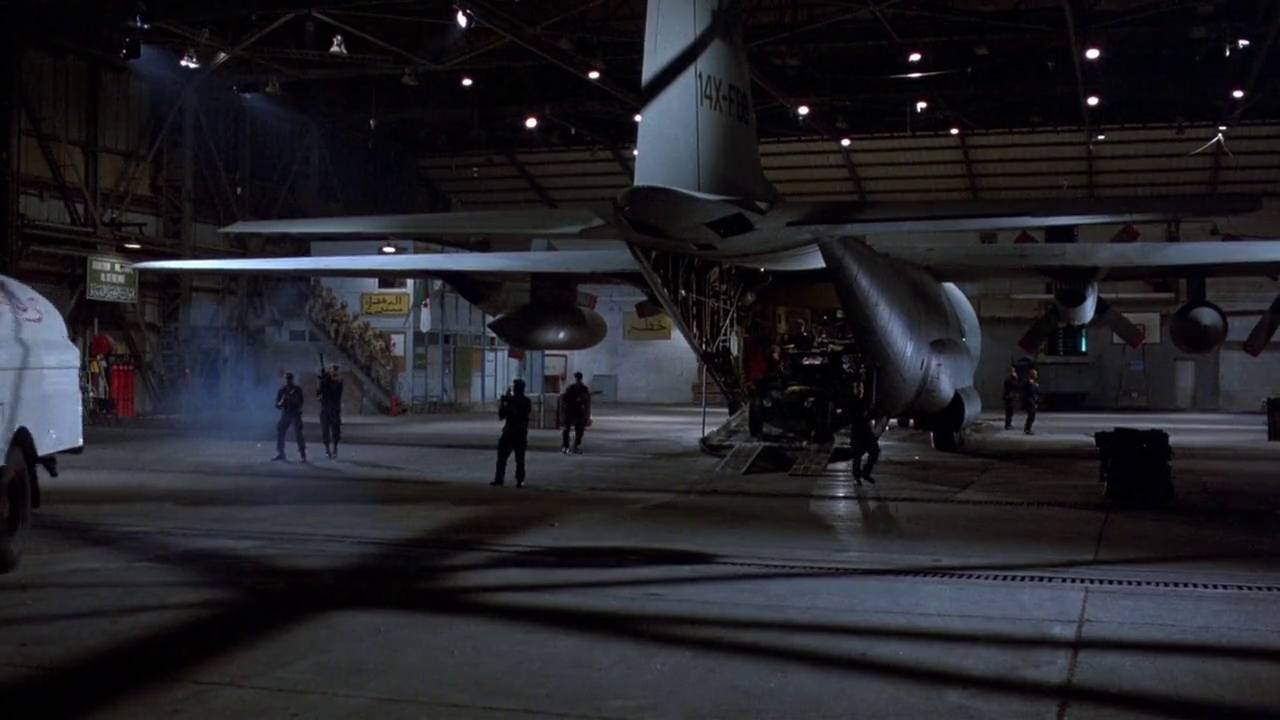 The jingoism of The Delta Force is hard to overlook: ‘America has been good to us’, one passenger notes early in the film, whilst after the Delta Force team has saved the day, as the plane is taking off the freed pilot tells the surviving New World Revolution members to ‘Have a nice day’ whilst the rest of the passengers sing ‘America the Beautiful’ and the Delta Force members hand out cans of Budweiser to the survivors. In the real hijacking that inspired the film, the final 39 passengers were driven to Syria and eventually released by the authorities there. By contrast, Golan’s film imagines a different conclusion to this series of events, one more in line with President Reagan’s comments after the real hostages were released (Reagan noted at a press conference, ‘Boy, I saw Rambo last night. Now I know what to do the next time this happens’), in which American military forces, supported by Israeli commandos, stage an all-out assault against the hijackers. In making his famous comment, Reagan was almost certainly referring to Rambo: First Blood, Part II (George Pan Cosmatos, 1985), in which John Rambo (Sylvester Stallone) is commissioned with the task of returning to Vietnam to help free missing American POWs left behind after America withdrew from Saigon – thus showing the Reagan administration righting an injustice left over from a previous era of American politics. In The Delta Force, the American forces have clear tactical and technological superiority, and the hijackers don’t stand a chance – regardless of the fact that, with their automatic weapons fire, they seem unable to hit targets that are either moving or stationary. Helena Vanhala notes that by highlighting the failure of the 1980 Operation Eagle Claw in its opening sequences, and juxtaposing this with the effective display of force in response to a similar threat at the film’s climax, The Delta Force ‘was reflecting on the Reagan administration’s view of the Carter administration and its perceived inability to take on international terrorism’ (2011: 163). The film’s climax offers a ‘celebration of Reagan-era American power’ (ibid.: 165). The jingoism of The Delta Force is hard to overlook: ‘America has been good to us’, one passenger notes early in the film, whilst after the Delta Force team has saved the day, as the plane is taking off the freed pilot tells the surviving New World Revolution members to ‘Have a nice day’ whilst the rest of the passengers sing ‘America the Beautiful’ and the Delta Force members hand out cans of Budweiser to the survivors. In the real hijacking that inspired the film, the final 39 passengers were driven to Syria and eventually released by the authorities there. By contrast, Golan’s film imagines a different conclusion to this series of events, one more in line with President Reagan’s comments after the real hostages were released (Reagan noted at a press conference, ‘Boy, I saw Rambo last night. Now I know what to do the next time this happens’), in which American military forces, supported by Israeli commandos, stage an all-out assault against the hijackers. In making his famous comment, Reagan was almost certainly referring to Rambo: First Blood, Part II (George Pan Cosmatos, 1985), in which John Rambo (Sylvester Stallone) is commissioned with the task of returning to Vietnam to help free missing American POWs left behind after America withdrew from Saigon – thus showing the Reagan administration righting an injustice left over from a previous era of American politics. In The Delta Force, the American forces have clear tactical and technological superiority, and the hijackers don’t stand a chance – regardless of the fact that, with their automatic weapons fire, they seem unable to hit targets that are either moving or stationary. Helena Vanhala notes that by highlighting the failure of the 1980 Operation Eagle Claw in its opening sequences, and juxtaposing this with the effective display of force in response to a similar threat at the film’s climax, The Delta Force ‘was reflecting on the Reagan administration’s view of the Carter administration and its perceived inability to take on international terrorism’ (2011: 163). The film’s climax offers a ‘celebration of Reagan-era American power’ (ibid.: 165).
Notably, where the previous year’s Invasion USA (Joseph Zito, 1985) had cast Chuck Norris as a loner hero who thwarts a terrorist attack on US soil, in The Delta Force Norris functions as a member of a team. Although he has several solo action sequences, including a brutal hand-to-hand battle with Robert Forster’s character, the film emphasises Norris’ relationships with his team mates: his selfless attempt to save one of his colleagues during the opening sequence, his warm yet distant relationship with Colonel Alexander, and his grief when another team member is killed as part of the operation. 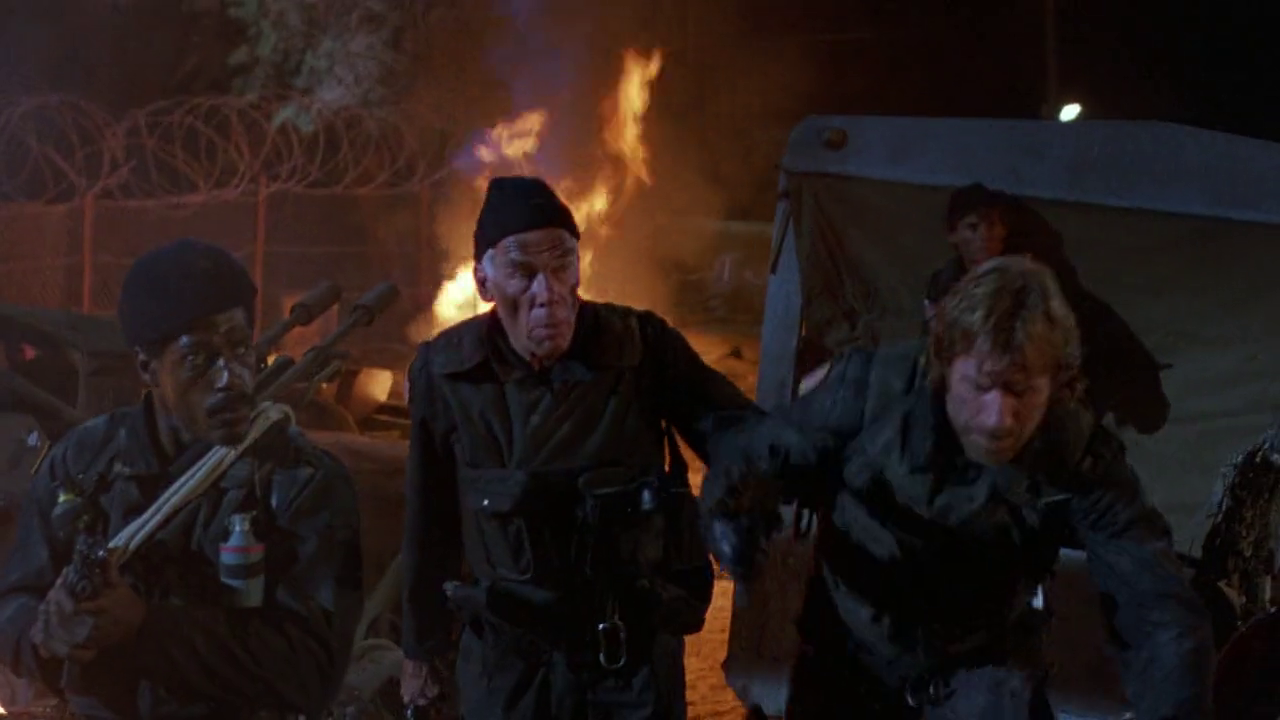 The team are openly critical of bureaucracy and the attempt to find non-violent solutions to the threats with which they are faced. Following the disastrous operation that opens the film, McCoy questions the orders that led to the incident: ‘Why the hell wouldn’t they listen, Nick?’, he asks Alexander, ‘We told them it was too dangerous to launch this operation at night’. McCoy adds that, ‘I spent five years in Vietnam watching them do the planning and us doing the dying’. Later, when the team discover that Woodridge is planning to try to negotiate with the hijackers, one of the Delta Force members asks Alexander, ‘We are gonna go for it this time, right, Colonel?’ The line, and its delivery, recalls the line delivered by Hudson (Bill Paxton) in James Cameron’s Aliens (released the same year as The Delta Force) as the Marines plan to disembark following their arrival at the alien-infested moon LV-426: ‘Is this going to be a stand-up fight, sir, or another bug hunt?’ The team are openly critical of bureaucracy and the attempt to find non-violent solutions to the threats with which they are faced. Following the disastrous operation that opens the film, McCoy questions the orders that led to the incident: ‘Why the hell wouldn’t they listen, Nick?’, he asks Alexander, ‘We told them it was too dangerous to launch this operation at night’. McCoy adds that, ‘I spent five years in Vietnam watching them do the planning and us doing the dying’. Later, when the team discover that Woodridge is planning to try to negotiate with the hijackers, one of the Delta Force members asks Alexander, ‘We are gonna go for it this time, right, Colonel?’ The line, and its delivery, recalls the line delivered by Hudson (Bill Paxton) in James Cameron’s Aliens (released the same year as The Delta Force) as the Marines plan to disembark following their arrival at the alien-infested moon LV-426: ‘Is this going to be a stand-up fight, sir, or another bug hunt?’
As Sally Totman notes in How Hollywood Projects Foreign Policy (2009), The Delta Force not only ‘brim[s] with Arab stereotypes’ but also likens the hijackers ‘to the Nazis and [portrays them] as hating everyone, particularly Jews, Christians, and Americans’ (166). The hijackers have no clear agenda. Where the hijackers of the TWA flight that inspired the film demanded the release of 700 Shia prisoners who were being held in Israel, Abdul and Mustafa make no demands. It is thus unclear what they hope to achieve through the hijacking of the plane, other than an attempt to strike back at those who they perceive as their oppressors. ‘We have declared war against the American Imperialists, Zionists, terrorists and all other anti-socialist atrocities’, Abdul tells the passengers: the hijackers belong to ‘an organization which mirrors the 1980s left-wing ideology fears, as well as Hezbollah’s anti-American and anti-Israeli stand’ (Vanhala, op cit.: 157). Vanhala suggests that this approach mirrors that of ‘news media portrayals of terrorism, which largely focus on the act as it is happening but [fail] to explore the motivations and background of terrorist organizations’ (ibid.: 164). In this way, terrorism remains ‘an incomprehensible and fearsome phenomenon’ (ibid.). Nevertheless, the purportedly left-leaning politics of the New World Revolution group ‘directly draw from the Reagan era experiences with an policies on terrorism: from an international communist and terrorist network, and from the Middle Eastern groups’ terrorist attacks against the U.S.’ (ibid.). The anti-American rhetoric of the hijackers is highlighted but the exact reason for their hatred of Americans is left ‘mythical [and] unexplainable’ (ibid.). Nevertheless, the villains are humanised by the film: for example, Mustafa responds kindly to a six year old girl, one of the hostages, telling her that he has a daughter of the same age; and he also ensures that a pregnant female hostage is comfortable. Although Abdul and Mustafa are stereotypical ‘terrorists’ and their motivations are left fairly ambiguous and, as Vanhala suggests, ‘unexplainable’, ‘against genre traditions they are not mad but rational in their actions otherwise’ (ibid.: 168). This ‘wooliness’ about the ideologies underlying acts of terror may be seen as fairly typical of Hollywood films about terrorism and hostage-taking, of course, and later films (such as John McTiernan’s Die Hard, 1988, and Andrew Davis’ Under Siege, 1992) would become even more wary of providing an ideological context for the acts of terror depicted within their narratives. In Die Hard, Hans Gruber (Alan Rickman) uses the agenda of a radical terrorist organisation as a smokescreen for his desire to steal 640 million dollars in bearer bonds. (‘After all your posturing, all your little speeches, you’re nothing but a common thief’, Holly McClane tells Gruber; ‘I am an exceptional thief, Mrs McClane; and since I’m moving up to kidnapping, you should be more polite’, Gruber responds.) Later films about similar acts of terrorism and hijacking, such as Executive Decision (Stuart Baird, 1996), would revert back to the kinds of stereotypes found in films such as The Delta Force, though the hijackers in Executive Decision are far less rational than those in The Delta Force – they are, as Vanhala notes, ‘full of rage to the point of insanity’ (op cit.: 234) – and the threat they present is tied in with the aftermath of the Cold War.
Video
Presented on a region ‘B’ encoded, dual-layered Blu-ray disc (and using the AVC codec), this presentation of The Delta Force is virtually identical to the MGM Blu-ray releases of the same film that were distributed in various countries (but not the UK) in 2012. Presented in an aspect ratio of 1.85:1, the film shows a strong level of detail and the kind of natural grain structure one would expect from a film shot on 35mm during the mid-1980s. However, as with the various MGM Blu-ray releases of the same film there are crushed blacks and some evidence of ringing artifacts (presumably owing to edge enhancement). The encode on the Arrow disc may be slightly stronger, but there’s little discernible difference between the Arrow disc and the MGM Blu-rays. Nevertheless, it’s a big step up from the DVD releases. 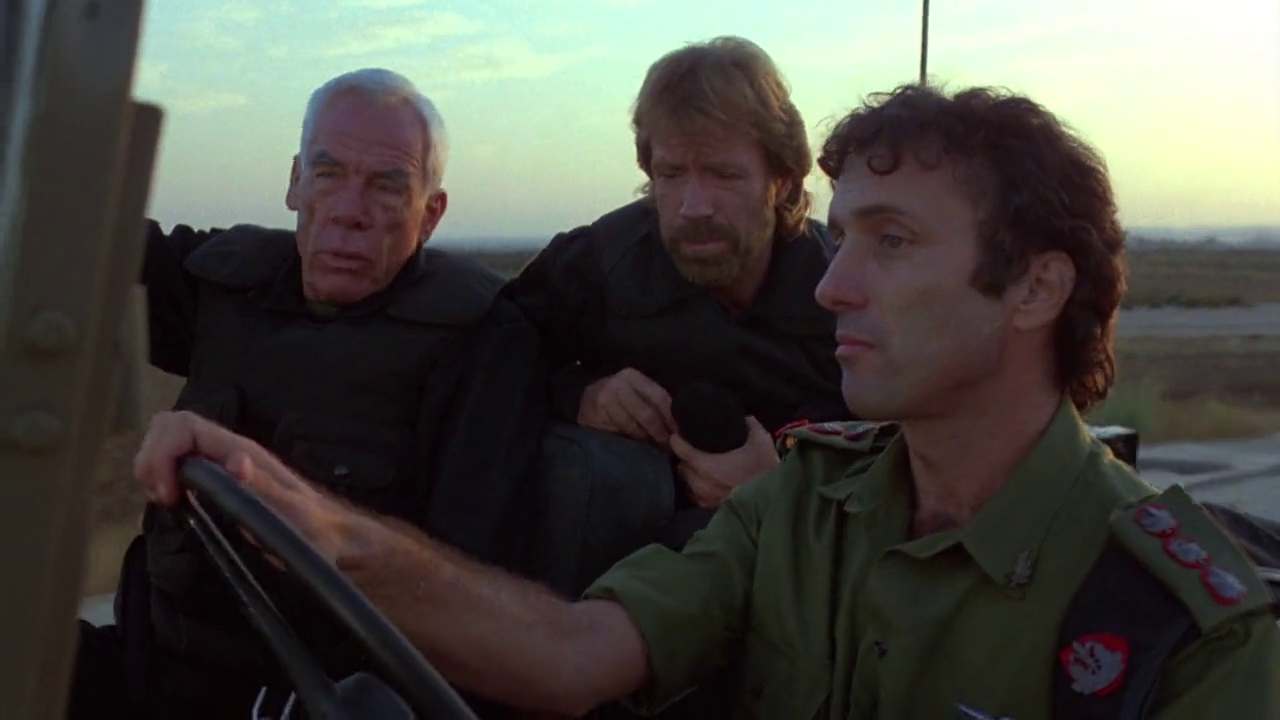
Audio
Audio is presented via a LPCM 2.0 stereo track, with optional English subtitles for the Hard of Hearing. Most of the film is in English, with some dialogue in Arabic. The portions of the dialogue that are in Arabic are presented with burnt-in English subtitles which, as with those on the MGM Blu-rays, contain fairly heavy dirt and debris. The audio track is clean and clear, with a dynamic soundscape: moments of quiet preparation are placed in juxtaposition with outbursts of violence where gunshots and explosions offer an immersive listening experience.
Extras
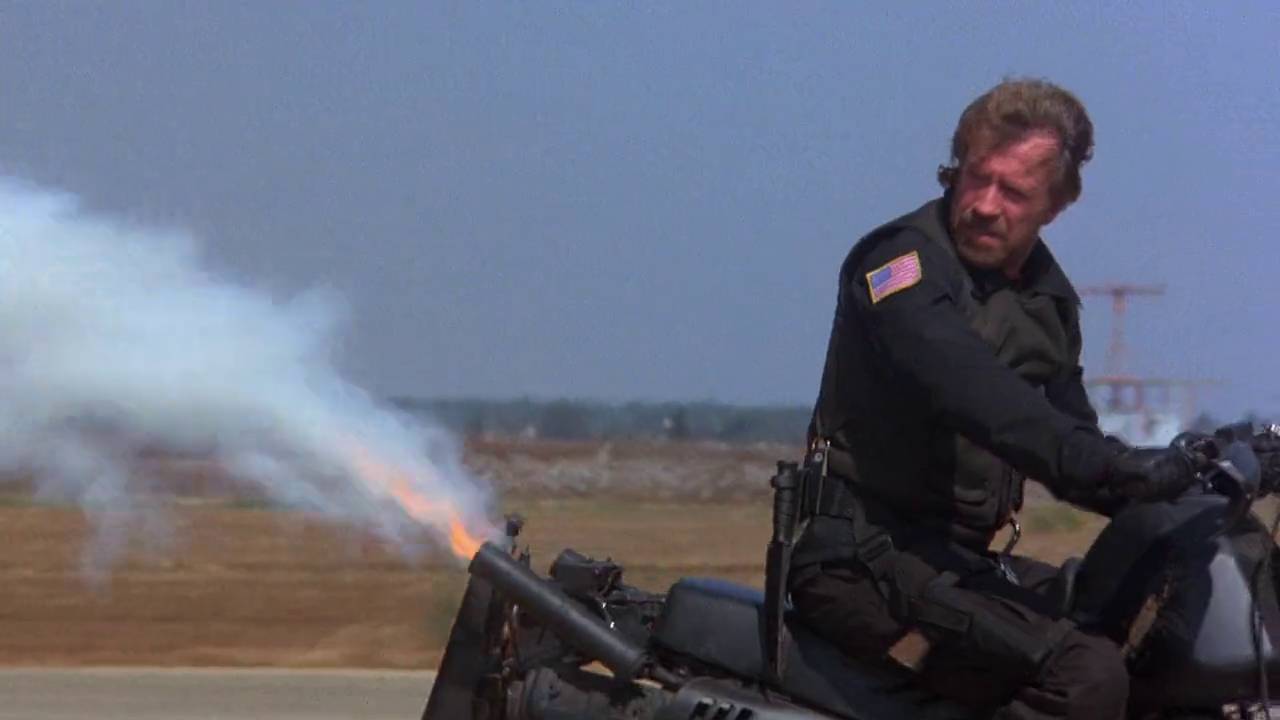 (All of the contextual material on the disc is in HD.) (All of the contextual material on the disc is in HD.)
Interviews - 'Genre Hijackers' (14:42) The Australian documentary maker Mark Hartley – whose documentary about Cannon Films, Electric Boogaloo: The Wild, Untold Story of Cannon Films – will hopefully be released this year, discusses the history of Cannon as a company ‘that brought Hollywood to people that couldn’t afford Hollywood’, selling their films to independent ‘distributors in countries that couldn’t afford to go to the major studios’. Hartley discusses Menahem Golan’s success as a director in Israel, with films like Lepke (1975), prior to his move to America. The Cannon productions, Hartley argues, ‘are really about delivering to the audience what they wanted, and with action films in the Eighties what they wanted was [a high onscreen] bodycount; it was as simple as that’. Cannon’s Chuck Norris vehicle Missing in Action ‘traded on the success of Rambo and of Uncommon Valor’ and was therefore a part of the zeitgeist. However, Hartley notes that ‘quality was [not] necessarily the number one agenda on the list [….] They [Cannon] were literally making any films that these stars [Charles Bronson and Chuck Norris] would appear in’. Discussing The Delta Force specifically, Hartley argues that ‘people love mission movies, and there’s only a finite number of mission movies; and eventually, we get round to watching Delta Force’. The film had its origins in Golan’s reading the newspaper reports of Operation Eagle Claw and his vow to ‘give the people the outcome that they wanted [….] and who better to give it to them than Lee Marvin and Chuck Norris, and who better to play the evil villain than Robert Forster with a particular overdeveloped tan’. Forster’s depiction of a Middle Eastern hijacker drew criticism at the time of the film’s release, but Hartley argues that ‘Robert Forster in brown-face is possibly no more politically incorrect than Alec Guinness in brown-face in a David Lean film’ Cannon ‘picked on talent that knew they had carte blanche in Cannon that they didn’t have anywhere else in the industry’, Hartley tells us; they hired directors such as J Lee Thompson and Michael Winner, ‘and these guys could bring their own style and personality and humour to Cannon films that they really couldn’t do when they work working for the studio systems [….] If nothing else, the films are filled with auteur personality’. Cannon would also ‘pick up dead franchises’: for example, in their production of Superman IV: The Quest for Peace (Sidney J Furie, 1987). Cannon also made ‘impenetrable’ art house films: for example, Jean-Luc Godard’s King Lear (1987)… ‘and to finance a film like King Lear, you have to make a film that appeals to the masses’. As Hartley notes, Cannon also produced films by Andrei Konchalovsky, JohnCassavetes’ (Love Streams, 1984) and Robert Altman Fool for Love (1985). Their real strength was in making art films, he argues, and the exploitative action films were a way of bankrolling these. They began to spend more money on films (Over the Top, Masters of the Universe) that were sadly ‘flops’, and ‘bought a lot of cinemas’ in the UK. Both of these factors led to their demise. However, the trends that Cannon exploited in the 1980s have become a part of mainstream Hollywood cinema, Hartley suggests: ‘It has taken this long for Hollywood to catch up with what Cannon thought audiences wanted’ – for example, films like Unstoppable (Tony Scott, 2010), which ‘takes its cues from [Konchalovsky’s] Runaway Train’, and films like Expendables (Sylvester Stallone, 2010) and Expendables 2 (Simon West, 2012), which look back to the themes and narratives of Cannon’s films and also feature many cast and crew members who worked with Cannon in the 1980s: as Hartley suggests at the end of this featurette, ‘[t]heir [Cannon’s] legacy is very strong now in Hollywood, possibly more strong than it ever has been’. - 'Chuck Norris Scribe' (21:48) This interview with the writer of The Delta Force, James Bruner, tells us something of Cannon’s approach to the production of its action films. From Wisconsin, Bruner had a background in martial arts but no writing experience. However, he ‘had an idea for an action movie with martial arts and guns’ which became An Eye for an Eye (Steve Carver, 1981). Bruner talks about his involvement in Force of One (Paul Aaron, 1979) and Missing in Action. He discusses the relationship between Missing in Action and Missing in Action 2: The Beginning, which as any Cannon/Norris fan knows was originally intended to be the first film in the series but was released after Missing in Action owing to the perception that it was the weaker film. He briefly talks about the background to the production of Invasion USA before moving onto a discussion of The Delta Force. The film was originally to feature Chuck Norris and Charles Bronson. The TWA hijacking took place as Bruner was writing the script and the film’s direction changed because of that, coming to focus on an aeroplane hijacking. During the TWA hijacking, Menahem Golan proposed sending Bruner to Beirut, undercover, so he could observe what was happening with the TWA hijacking. This didn’t come to pass, however, much to Bruner’s pleasure as it would have been highly dangerous. Joseph Zito was originally to direct The Delta Force but Golan saw it as a similar film to his own Operation Thunderbolt and decided to direct it himself. Jim Monahan, an ex-Green Beret who had served during the Vietnam War, ‘was hired as the military technical advisor on the film’ and had friends who were in the real Delta Force, and some of the techniques of the real Delta Force worked their way into the film. This caused conflict with Golan, who wanted instead to use Israeli commando techniques in the film. According to Bruner, Golan wanted the hijackers to be ‘ruthless, violent, and then they’ll do very human things’ such as caring for the pregnant female passenger. Much of the film is shot in a documentary style, but this is offset with ‘huge’ action sequences: ‘the docudrama, the hostages we care about, and here’s this fullblown action movie stuff. It really is a juxtaposition of two genres’. Interestingly, Bruner tells us that the original assembly of the picture ran for four hours, with much more of Ingrid’s storyline, but much of this was cut out to bring focus on the action. Bruner reflects on the end of his career as a writer for Cannon Films, suggesting that the original script for Braddock: Missing in Action III (Aaron Norris, 1988) ‘was probably the best script I’d written’ but went through a number of changes as the project went through the hands of several directors and the budget kept being cut back. Bruner decided to retire from writing after Braddock when Golan demanded that Bruner only take half of his salary, threatening him, ‘If you don’t take half your salary, you’ll never work for Cannon again’. He’s happy with the longevity of the films, however. - 'May the Delta Force Be With You!' (23:20) Commandant Christian Prouteau, founder of the French GIGN and instructor of the first Delta Force, discusses the history of modern counter-terrorist methods and the development of the Delta Force. The interview is in French with optional English subtitles. Trailer (1:56)
Overall
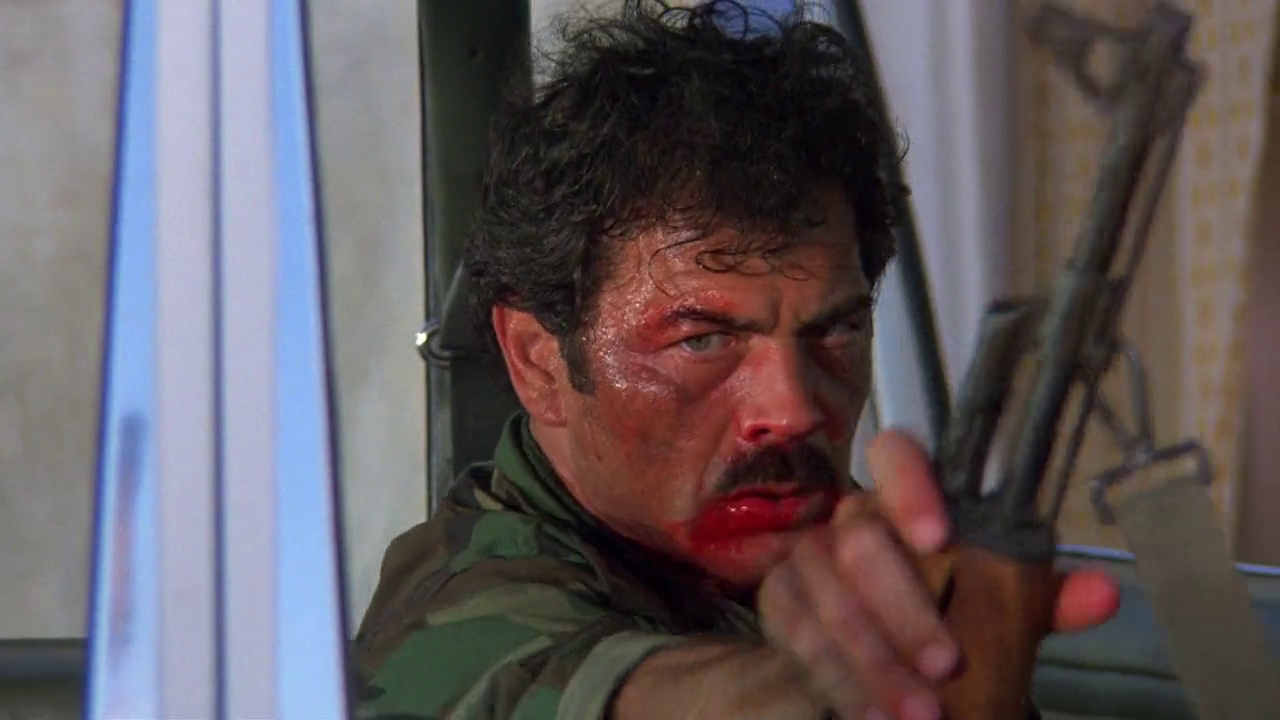 The Delta Force is a condensed version of the characteristics of the Reagan era action picture: ‘[i]nterracial harmony, strong [symbolic] father-son relationships, male bonding, and the absence of women, spiced up with abundant use of violence against Reagan-era enemies’ (Vanhala, op cit.: 167). In its exploration of the use of force as a response to the hijacking, the film looks back ‘to the iconography of the films made about the Israeli rescue at Entebbe’ with ‘Entebbe function[ing] as the successful (Israeli) model that could revise the U.S. failure in Iran’ in 1980 (McAlister, op cit.: 227). Menahem Golan had directed one of these films, Operation Thunderbolt (1976), which had been submitted by Israel as their official entry into the 1977 Academy Awards. As Melani McAlister notes, the similarities between The Delta Force and Operation Thunderbolt are strong: both films feature a number of the same actors and draw ‘on a similar set of characterizations of the passengers. The Arab terrorists, the Holocaust-scarred Jews, and the noble Gentiles are all near-direct replications’ (ibid.). The closing sequences of both films are also very similar: both films end with the now-freed hostages celebrating their release whilst a member of the military team responsible for their freedom is dying. The Delta Force is a condensed version of the characteristics of the Reagan era action picture: ‘[i]nterracial harmony, strong [symbolic] father-son relationships, male bonding, and the absence of women, spiced up with abundant use of violence against Reagan-era enemies’ (Vanhala, op cit.: 167). In its exploration of the use of force as a response to the hijacking, the film looks back ‘to the iconography of the films made about the Israeli rescue at Entebbe’ with ‘Entebbe function[ing] as the successful (Israeli) model that could revise the U.S. failure in Iran’ in 1980 (McAlister, op cit.: 227). Menahem Golan had directed one of these films, Operation Thunderbolt (1976), which had been submitted by Israel as their official entry into the 1977 Academy Awards. As Melani McAlister notes, the similarities between The Delta Force and Operation Thunderbolt are strong: both films feature a number of the same actors and draw ‘on a similar set of characterizations of the passengers. The Arab terrorists, the Holocaust-scarred Jews, and the noble Gentiles are all near-direct replications’ (ibid.). The closing sequences of both films are also very similar: both films end with the now-freed hostages celebrating their release whilst a member of the military team responsible for their freedom is dying.
The juxtaposition of the semi-documentary approach of the establishing sequences and the outlandish, spectacular violence of the climax is a little jarring, and there are some ludicrous touches – notably the rocket/machine gun/mortar-firing motorcycle that Norris uses in the second half of the film. Nevertheless, it’s difficult not to be thrilled as Norris (or rather, his stunt double) rides to the rescue at the climax, performing motorcycle stunts galore. Clichés riddle the narrative, from the approach to the hijackers’ ideological background to the jingoism of the climax – and especially the juxtaposition of the hostages’ celebration of their freedom with the tragic death of one of the soldiers who liberated them. However, regardless of the film’s reliance on clichés, The Delta Force is a fun picture that distils the approach of Cannon, whose films have attracted a strong cult following. For those who have a deep nostalgia for this era of naïve but exciting action films, The Delta Force is required viewing. In terms of the presentation of the film, Arrow’s release is very similar (almost identical, one may argue) to the various MGM Blu-rays. The encode may be slightly stronger on the Arrow disc, but the differences between the film’s presentation on the Arrow and MGM Blu-rays are marginal: both releases offer a strong, quite natural transfer which has some intermittent issues with crushed blacks and ringing artifacts. However, in terms of contextual material the Arrow release is head and shoulders above the MGM Blu-rays, which are barebones. Fans of the film will find the interviews on this disc interesting and illuminating, and the interview with Mark Hartley will whet viewers’ appetites for Hartley’s forthcoming documentary about Cannon, Electric Boogaloo. For fans of 1980s action pictures, this release of The Delta Force will be more than satisfying. References: Lichtenfield, Eric, 2007: Action Speaks Louder: Violence, Spectacle, and the American Action Movie. Wesleyan University Press McAlister, Melani, 2005: Epic Encounters: Culture, Media, and U.S. Interests in the Middle East Since 1945. University of California Press Totman, Sally, 2009: How Hollywood Project Foreign Policy. London: Palgrave MacMillan Vanhala, Helena, 2011: The Depiction of Terrorists in Blockbuster Hollywood Films, 1980-2001: An Analytical Study. London: McFarland
|
|||||

|